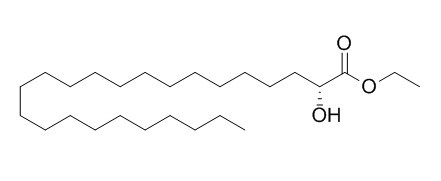2-Hydroxytetracosanoic acid ethyl ester
2-Hydroxytetracosanoic acid has antimalarial activity, and cytotoxicity on human cancer cell lines.
Inquire / Order:
manager@chemfaces.com
Technical Inquiries:
service@chemfaces.com
Tel:
+86-27-84237783
Fax:
+86-27-84254680
Address:
1 Building, No. 83, CheCheng Rd., Wuhan Economic and Technological Development Zone, Wuhan, Hubei 430056, PRC
Providing storage is as stated on the product vial and the vial is kept tightly sealed, the product can be stored for up to
24 months(2-8C).
Wherever possible, you should prepare and use solutions on the same day. However, if you need to make up stock solutions in advance, we recommend that you store the solution as aliquots in tightly sealed vials at -20C. Generally, these will be useable for up to two weeks. Before use, and prior to opening the vial we recommend that you allow your product to equilibrate to room temperature for at least 1 hour.
Need more advice on solubility, usage and handling? Please email to: service@chemfaces.com
The packaging of the product may have turned upside down during transportation, resulting in the natural compounds adhering to the neck or cap of the vial. take the vial out of its packaging and gently shake to let the compounds fall to the bottom of the vial. for liquid products, centrifuge at 200-500 RPM to gather the liquid at the bottom of the vial. try to avoid loss or contamination during handling.
Proc Biol Sci.2024, 291(2015):20232578.
J Ethnopharmacol.2016, 194:219-227
Chin Med.2022, 17(1):66.
Life (Basel).2021, 11(7):616.
Chem Biol Interact.2024, 398:111103.
Korean Journal of Pharmacognosy2019, 50(4):285-290
Biomolecules.2020, 10(2):E184
Front Pharmacol.2021, 12:762829.
Phytother Res.2022, 10.1002:ptr.7626.
Int J Mol Sci.2024, 25(15):8101.
Related and Featured Products
Marine Drugs,2013,11(4):1304-15.
Antimalarial Activity of Axidjiferosides, New β-Galactosylceramides from the African Sponge Axinyssa djiferi.[Reference:
WebLink]
METHODS AND RESULTS:
The marine sponge, Axinyssa djiferi, collected on mangrove tree roots in Senegal, was investigated for glycolipids. A mixture containing new glycosphingolipids, named axidjiferoside-A, -B and -C, accounted for 0.07% of sponge biomass (dry weight) and for 2.16% of total lipids. It showed a significant antimalarial activity, with a 50% inhibitory concentration (IC50) of 0.53 ± 0.2 μM against a chloroquine-resistant strain of Plasmodium falciparum. They were identified as homologous β-galactopyranosylceramides composed of 2-amino-(6E)-octadec-6-en-1,3,4-triol, and the major one, axidjiferoside-A (around 60%), contained 2-hydroxytetracosanoic acid(2-Hydroxytetracosanoic acid ethyl ester). Cytotoxicity was studied in vitro on human cancer cell lines (multiple myeloma, colorectal adenocarcinoma, glioblastoma and two lung cancer NSCLC-N6 and A549). Results of this investigation showed that axidjiferosides are of interest, because they proved a good antiplasmodial activity, with only a low cytotoxicity against various human cell lines and no significant antitrypanosomal and antileishmanial activity.
CONCLUSIONS:
Thus, it seems that galactosylceramides with a β anomeric configuration may be suitable in searching for new antimalarial drugs.



